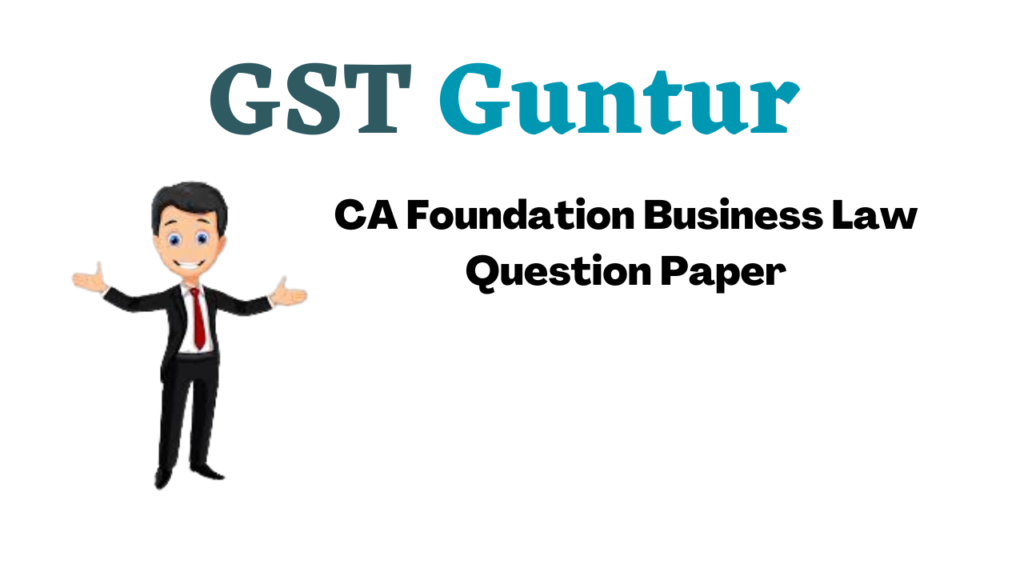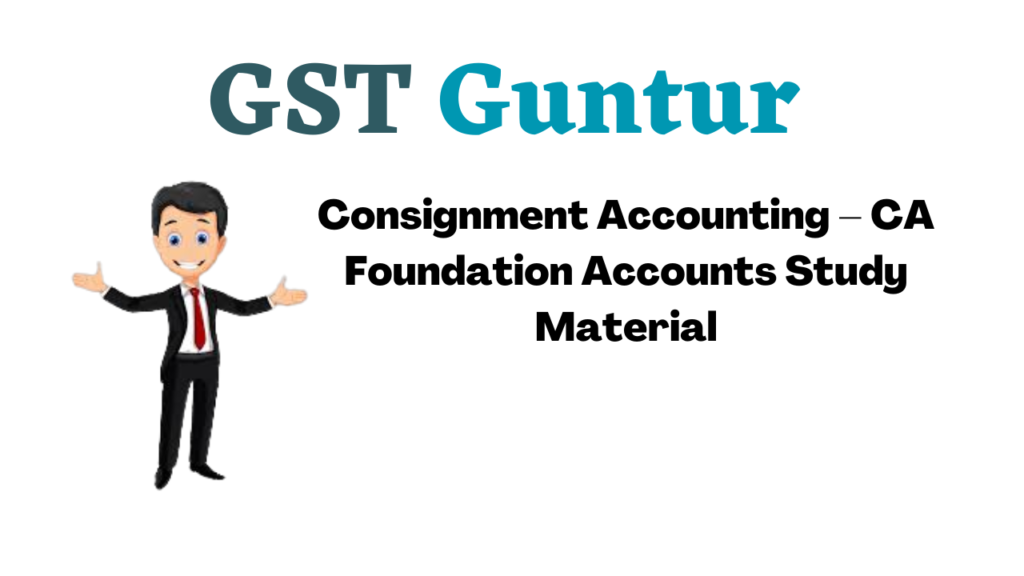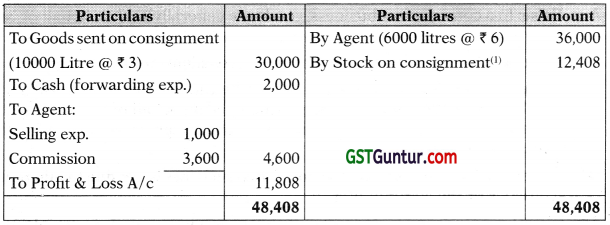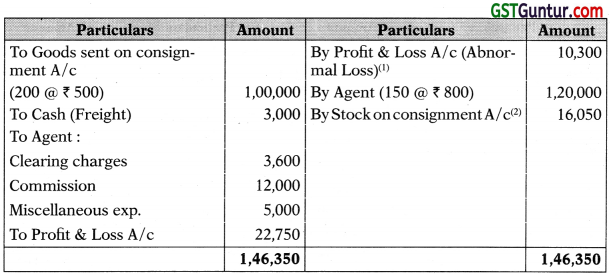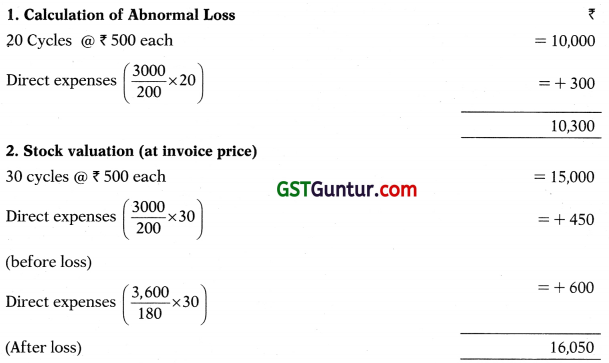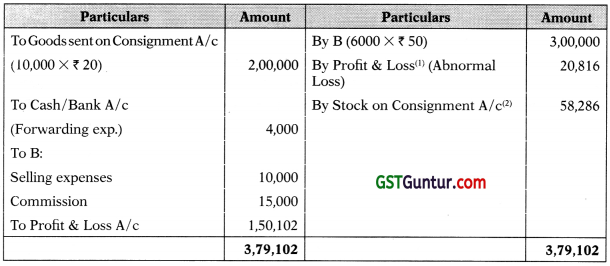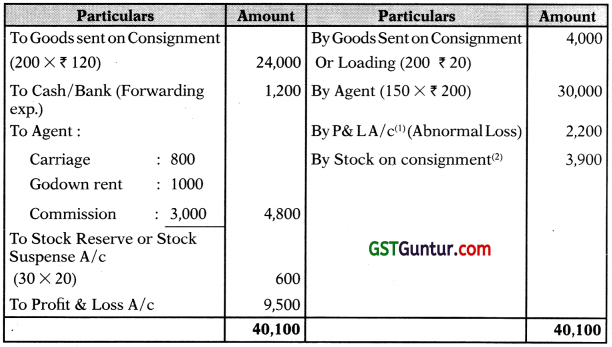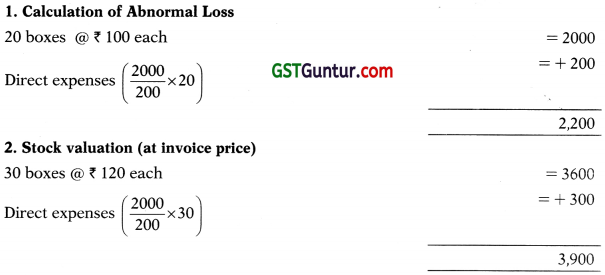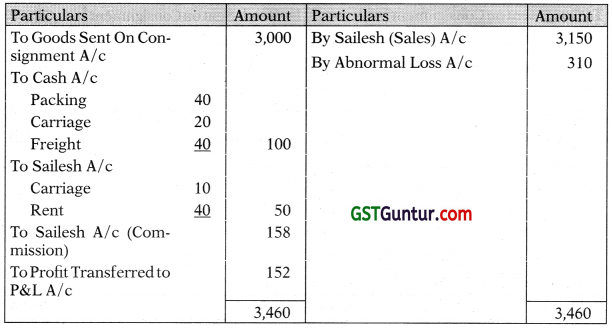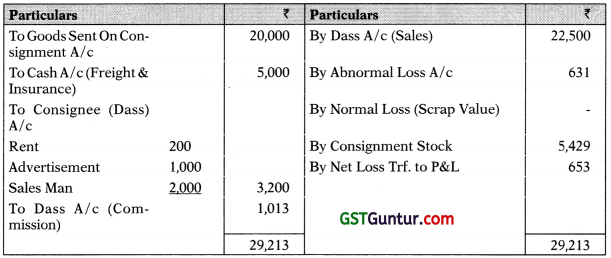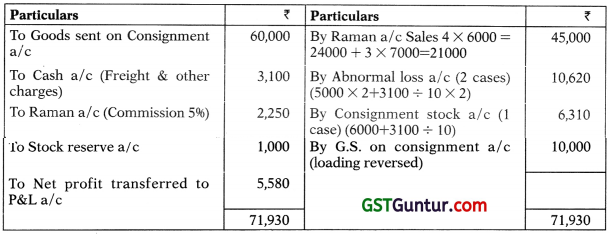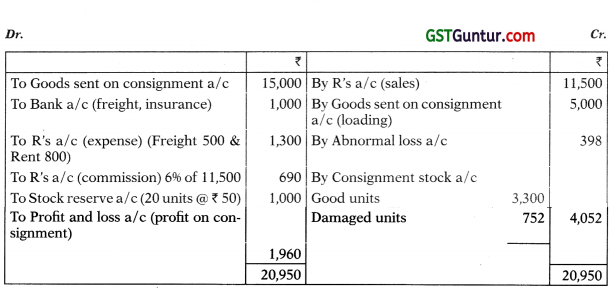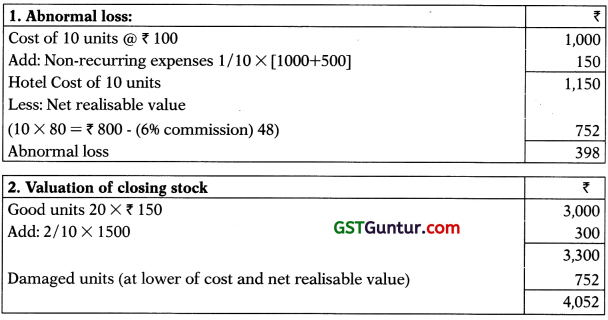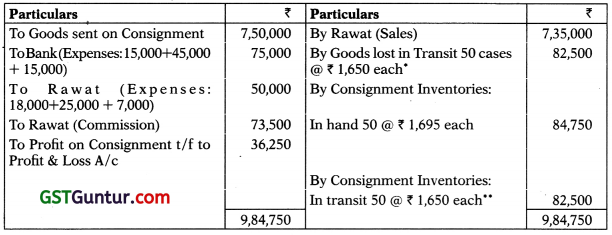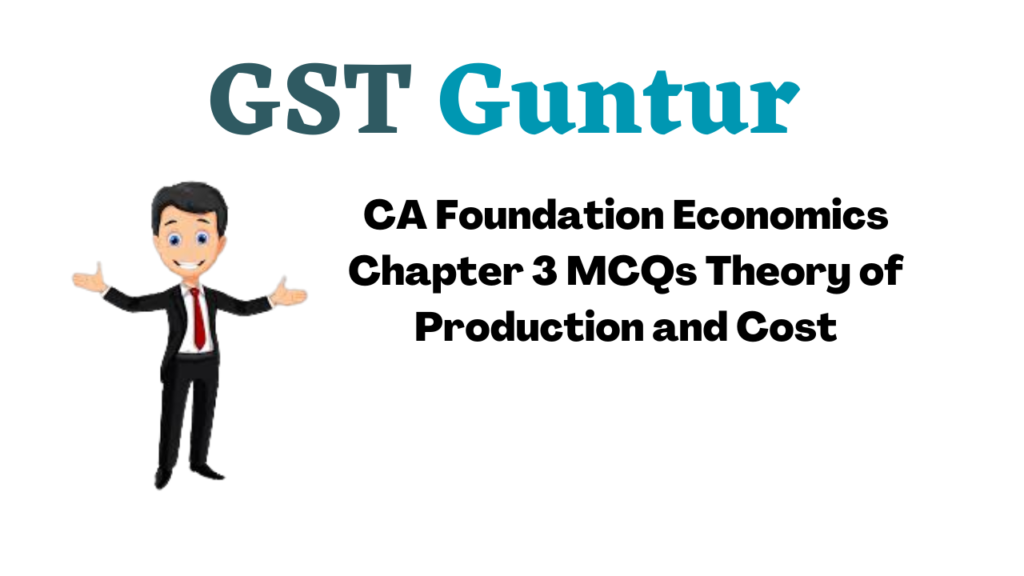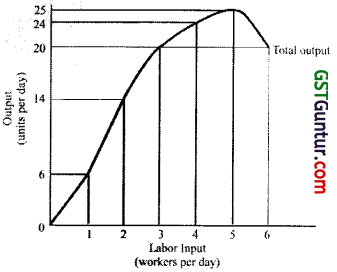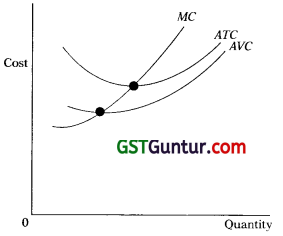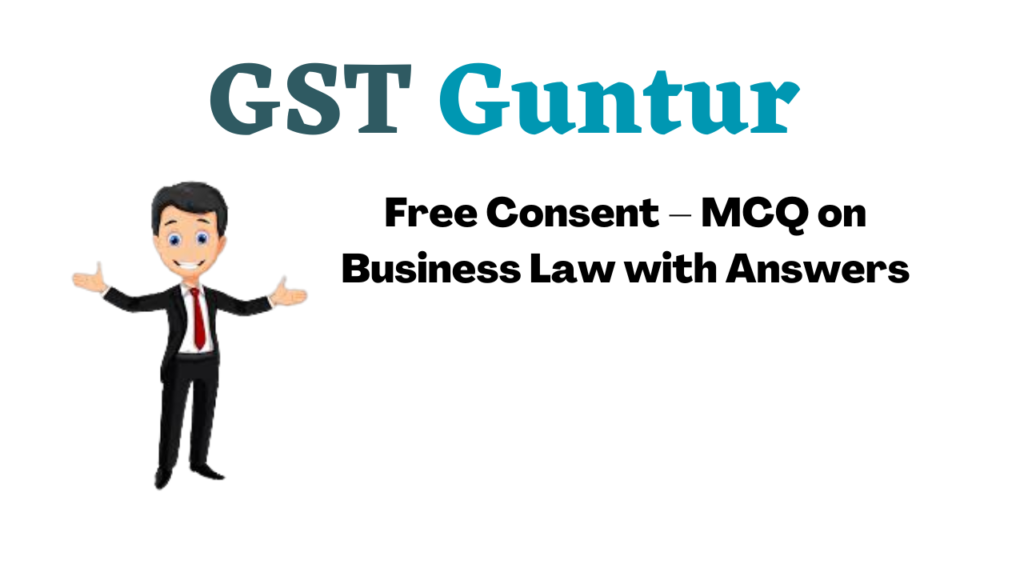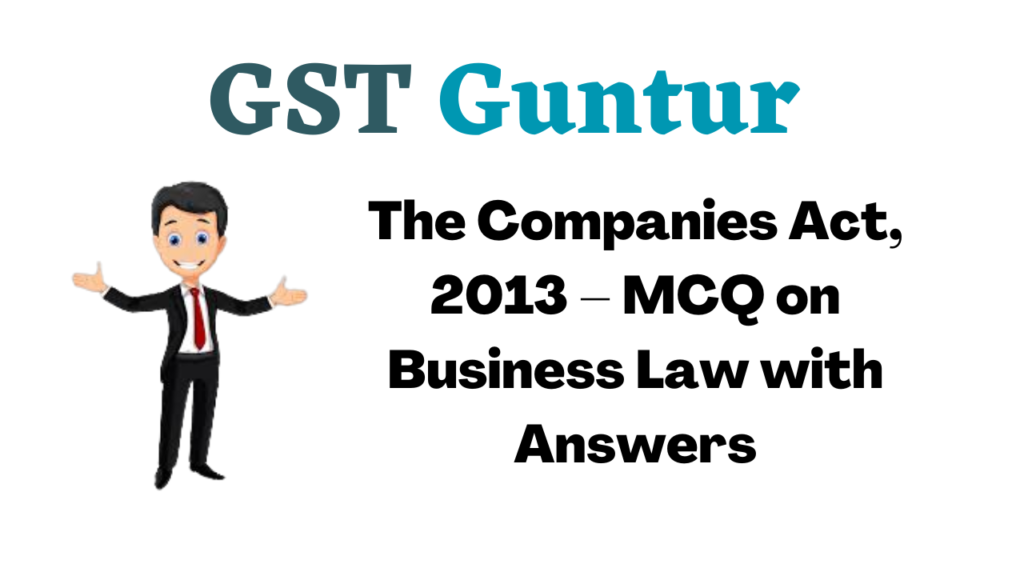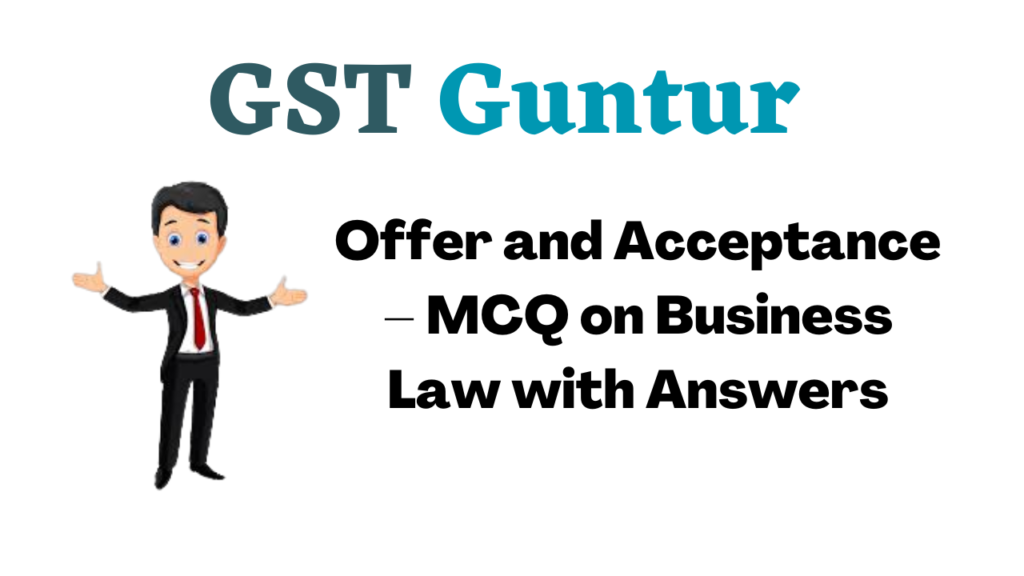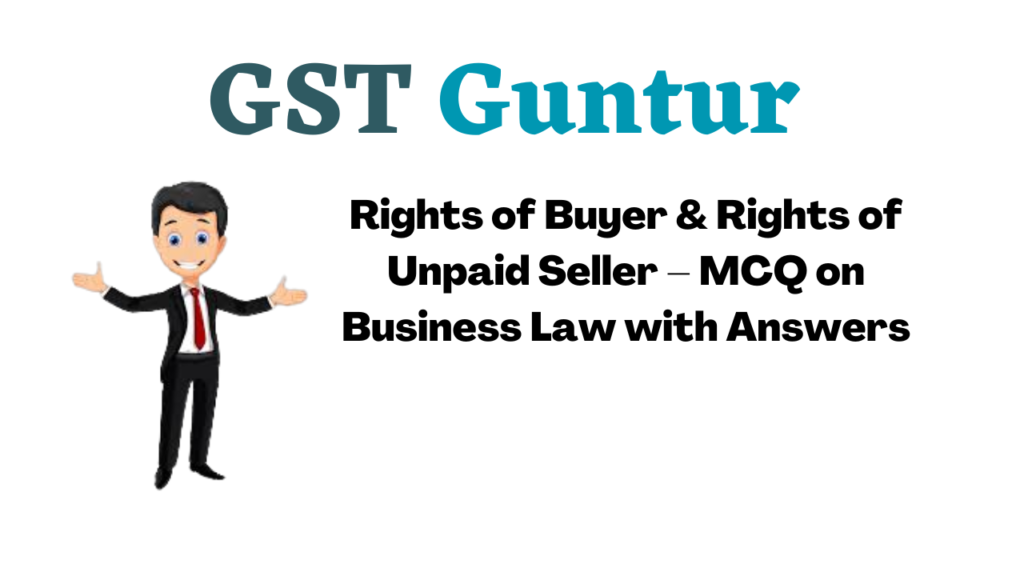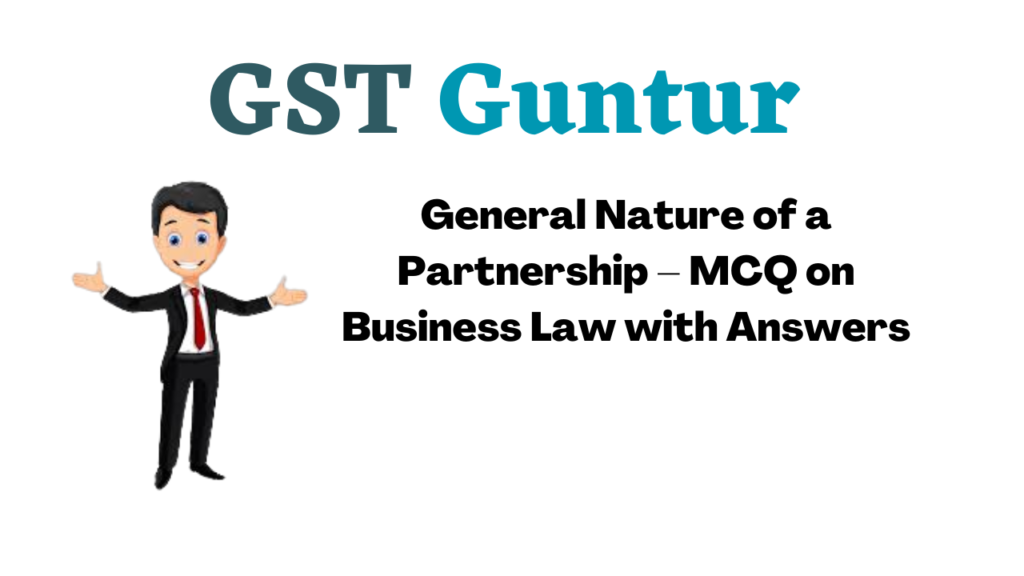CA Foundation Business Law Question Paper
This CA Foundation Law Notes CA Foundation Business Law Question Paper is designed strictly as per the latest syllabus and exam pattern.
CA Foundation Business Law Question Paper
SECTION A – Marks: 60
Question 1.
(a) Mr. X a businessman has been fighting long-drawn litigation with Mr. Y an industrialist. To support his legal campaign he enlists the services of Mr. C a Judicial officer stating that the amount of ₹ 10 lakhs would be paid to him if he does not take up the brief of Mr. Y.
Mr. C agrees but, at the end of the litigation, Mr. X refuses to pay Mr. C. Decide whether Mr. C can recover the amount promised by Mr. X under the provisions of the Indian Contract Act, 1872? (4 Marks)
(b) ABC Limited has allotted equity shares with voting rights to XYZ Limited worth ₹ 15 Crores and issued Non-Convertible Debentures worth ₹ 40 Crores during the Financial Year 2019-20. After that total Paid-up Equity Share Capital of the company is ₹ 100 Crores and Non-Convertible Debentures Stand at ₹ 120 Crores. Define the Meaning of Associate Company and comment on whether ABC Limited and XYZ Limited would be called Associate Company as per the provisions of the Companies Act, 2013? (4 Marks)
(c) Write any four exceptions to the doctrine of Caveat Emptor as per the Sale of Goods Act, 1930. (4 Marks)
Answer:
1. (a) See answer from Chapter 7: Void Agreement, under Unit 1: The Indian Contract Act, 1872 – Pg. 7.6, Q & Ans. 9.
Thus the agreement is valid and enforceable since the restraint imposed on Mr. C does not amount to restraint of trade and Mr. C can recover the amount from Mr. X.
(b) According to the provisions of section 2(6) of the Companies Act, 2013 an Associate Company in relation to another company means a company in which that other company has a significant influence, but which is not a subsidiary company of the company having such influence and includes a joint venture company. For the purpose of this clause: the expression “significant influence” means control of at least 20% of total voting power or control of or participation in business decisions under an agreement.
In the given case XYZ Ltd. is holding Equity shares with voting rights worth ₹ 15 crores and Non-convertible debentures worth ₹ Rs. 40 crores in ABC Ltd. Further in computing “significant influence” as aforesaid, the holding in respect of Non-convertible debentures shall not be considered since they do not carry voting rights.
It is therefore evident that XYZ Ltd. holds voting rights amounting to only 1596 of the total voting power (15/100*100) of ABC Ltd. which is less than 20% of total voting power required minimally to be regarded as a significant influence. Thus it can be concluded that ABC Ltd. is not the Associate Company of XYZ Ltd.
(c) See answer from Chapter 12: Conditions & Warranties, under Unit 2: Sale of Goods Act, 1930 – Pg. 12.3, Q & Ans. 3. – Exceptions.
Question 2.
(a) Define Misrepresentation and Fraud. Explain the difference between Fraud and Misrepresentation as per the Indian Contract Act, 1872. (7 Marks)
(b) State the circumstances under which LLP may be wound up by the Tribunal under the Limited Liability Partnership Act, 2008. (5 Marks)
Answer:
2. (a) Definition
Fraud: See answer from Chapter 5: Free Consent, under Unit 1: The Indian Contract Act, 1872 – Pg. 5.1, Q & Ans. 1. (part up to the definition of Fraud)
Misrepresentation:
According to the provisions of section 18 of the Indian Contract Act, 1872, misrepresentation means and includes:
- positive assertion of such fact, which is not true, in a manner not warranted by the information of the person making it, though he believes it to be true;
- any breach of duty, which without any intent to deceive, gains an advantage to the person committing it, or anyone claiming under him, by misleading another to his prejudice or to the prejudice of anyone claiming under him;
- causing, however innocently, a party to an agreement to make a mistake as to the substance of the thing which is the subject of the agreement.
Thus misrepresentation is an innocent and unintentional false/ wrong statement made without the positive knowledge of falsehood by a person who himself believes it to be true and makes such representations without any intent to deceive.
Difference between Fraud & Misrepresentation from Chapter 5: Free Consent, under Unit 1: The Indian Contract Act, 1872 – Pg. 5.6, Q & Ans. 8 (b)
(b) See answer from Chapter 18: Limited Liability Partnership Act, 2008, under Unit 4: Limited Liability Partnership Act, 2008 – Pg. 18.13, Q & Ans. 13.
Question 3.
(a) (1) What do you mean by ‘Partnership at will’ as per the Indian Partnership Act, 1932? (2 Marks)
OR
(2) Comment on ‘the right to expel partner must be exercised in good faith’ under the Indian Partnership Act, 1932.
(b) Referring to the Provisions of the Indian Partnership Act, 1932, answer the following: (4 Marks)
- What are the consequences of Non-Registration of Partnership firms?
- What are the rights which won’t be affected by the Non-Registration of the Partnership firm?
(c) In light of provisions of the Indian Contract Act, 1872 answer the following: (6 Marks)
- Mr. S and Mr. R made a contract wherein Mr. S agreed to deliver a paper cup manufacture machine to Mr. R and to receive payment on delivery. On the delivery date, Mr. R didn’t pay the agreed price. Decide whether Mr. S is bound to fulfill his promise at the time of delivery?
- Mr. Y was given a loan to Mr. G of INR 30,00,000. Mr. G defaulted the loan on the due date and the debt became time-barred. After the time-barred debt, Mr. G agreed to settle the full amount to Mr. Y. Whether acceptance of the time-barred debt Contract is enforceable in law?
- A & B entered into a contract to supply unique items, alternate of which is not available in the market. A refused to supply the agreed unique item to B. What directions could be given by the court for breach of such contract?
Answer:
3. (a) (1) See answer from Chapter 15: General Nature of a Partnership, under Unit 3: The Indian Partnership Act, 1932 – Pg. 15.6, Q & Ans. 4(1)- Partnership at will
OR
(2) According to the provisions of Section 33 of the Indian Partnership Act, 1932, a partner may not be expelled from the firm by a majority of partners except by exercise in good faith, of the powers conferred by contract between the partners. It is thus essential that:
- The power of expulsion must have existed in the contract between the partners or expressly stated in the deed;
- The power of expulsion has been exercised by a majority of the partners and
- The power of expulsion has been exercised in good faith.
If all the above conditions are satisfied only then the expulsion is treated as valid and effective and in the bona fide interest of the business of the firm. Further for the power of expulsion to have been exercised in good faith, the test of the following is required:
- The expulsion must be in the interest of the partnership
- The partner to be expelled is served with reasonable notice of expulsion &
- He is given a fair and reasonable opportunity of being heard.
If a partner is expelled otherwise, not only the expulsion is treated as null and void, but at the same time, such an expelled partner shall have a right to proceed against the other partners in a court of law and seek reinstatement as a partner in the firm.
(b) See answer from Chapter 17: Registration of a Firm & Dissolution of a firm, under Unit 3: The Indian Partnership Act, 1932-Pg. 17.2, Q&Ans. 2-Consequences of Non- Registration of partnership and rights unaffected by non-registration.
(c) (1) According to the provisions of Section 51 of the Indian Contract Act, 1872, in the case of a contract consisting of reciprocal promises which are mutual and dependent, the performance of both the promises is required simultaneously. Thus in the case of reciprocal promises, the promisor need not perform his part of the promise unless the promisee is ready and willing to perform his part of the reciprocal promise.
In the given case, Mr. S & Mr. R by way of reciprocal promises contracted to deliver paper cup manufacturing machine and pay on delivery respectively. However, on the date of delivery, Mr. R refuses to pay the agreed price.
Thus applying the above-stated provision it can be concluded that since Mr. R has refused to perform his part of the reciprocal promise, the promisor, Mr. S is also thereby discharged from giving his performance under the contract.
(2) According to the provisions of section 25(3) of the Indian Contract Act, 1872, a promise to pay a time-barred debt is generally not enforceable, since it is without consideration. However, if the following conditions are fulfilled the same shall be validly enforceable:
- Such a promise is made by the debtor in writing
- In respect of a debt which has become time-barred by the law of limitations &
- The promise is signed by the debtor or his authorized agent.
In the given case Mr. G agrees to settle the amount of the time-barred debt of Rs. 30,00,000, owed by him to Mr. Y. Applying the above-stated provisions it can be concluded that if the promise to pay the time-barred debt by Mr. G, is not in writing and is not signed by him or his duly authorized agent, the same cannot be enforced by Mr. Y.
(3) According to the provisions of the Indian Contract Act, 1872, in the event of a breach of a contract, where the amount of damages sustained by the aggrieved party cannot be determined or where the number of damages is not adequate, then the court may award specific performance as a remedy for breach. An order for specific performance implies that the defaulting party shall have to perform the contract in accordance with the stipulated terms. One of the instances where Specific performance of a contract is awarded as a remedy, at the discretion of the court, is when the goods contracted for are unique or rare in nature.
In the given case A refused to supply a unique item to B which is not available in alternatively in the market. Applying the above provisions it can be concluded that since B cannot be adequately compensated for the breach, thus the court may as a remedy for breach to B, order A for specific performance in accordance with the terms of the contract.
Question 4.
(a) Explain any six circumstances in detail in which non-owner can convey better title to bona fide purchaser of goods for value as per The Sale of Goods Act, 1930. (6 Marks)
(b) P, Q, R and S are the partners in M/S PQRS & Co., a partnership firm that deals in trading of Washing Machines of various brands.
Due to the conflict of views between partners, P & Q decided to leave the partnership firm and started competitive business on 31st July, 2019, in the name of M/s PQ & Co. Meanwhile, R & S have continued using the property in the name of M/s PQRS & Co. in which P & Q also has a share.
Based on the above facts, explain in detail the rights of outgoing partners as per the Indian Partnership Act, 1932 and comment on the following:
- Rights of P & Q to start a competitive business.
- Rights of P & Q regarding their share in property of M/s PQRS &Co. (6 Marks)
Answer:
4. (a) See answer from Chapter 13: Transfer of Ownership, under Unit 2: Sale of Goods Act, 1930 – Pg. 13.2, Q & Ans. 2 – Instances when a non-owner can convey a better title to a bona fide purchaser of goods.
(b) (1) According to the provisions of section 36 of the Indian Partnership Act, 1932, an outgoing partner has the right to carry on a business competing with that of the firm and also to advertise the same, provided no (reasonable) restraint on the same has been expressly provided by an agreement to the contrary, made with a view to safeguarding the interest of the firm. However, the outgoing partner may not:
- use the firm’s name,
- represent himself as carrying on the business on behalf of the firm or
- solicit the customers of the firm.
In the given case the outgoing partners P & Q started carrying on a competing business in the name of M/s PQ & Co., which is not the name of the firm. Moreover, no restriction appears to be imposed on such outgoing partners whereby they may be reasonably restrained from carrying on a competing business.
Thus applying the above-stated provisions it can be concluded that outgoing partners, P & Q can validly carry on a competing business as it is in accordance with the requirements of law.
(2) Section 37 of the Indian Partnership Act, 1932 provides that in case the accounts of the outgoing partners remain unsettled and the remaining partners continue to carry on the business of the firm, such an outgoing partner is entitled to receive any of the following whichever is more beneficial to him:
- Interest at the rate of 6 % p.a. on the amount of his share in the property of the firm.
- Alternatively, he may claim such share in the subsequent profits of the firm as is attributable to his share in capital employed in the business of the firm.
In the given case as the firm continues to carry on its business as before without settlement of accounts, the outgoing partners P&Q can ask for a share in the subsequent profits made by the firm as attributable to their share in capital employed or alternatively ask for interest @ 696 on their share from the firm, whichever is beneficial for them.
Question 5.
(a) Ms. R owns a Two Wheeler which she handed over to her friend Ms. K on a sale or return basis. Even after a week Ms. K neither returned the vehicle nor made payment for it. She instead pledged the vehicle to Mr. A to obtain a loan. Ms. R now wants to claim the Two Wheeler from Mr. A. Will she succeed?
- Examine with reference to the provisions of the Sale of Goods Act, 1930, what recourse is available to Ms. R?
- Would your answer be different if it had been expressly provided that the vehicle would remain the property of Ms. R until the price has been paid? (6 Marks)
(b) What are the significant points of section 8 company which are not applicable for other companies? Briefly explain with reference to provisions of the Companies Act, 2013. (6 Marks)
Answer:
5. (a) (1) According to the provisions of section 24 of the Sale of Goods Act, 1930, when the goods are delivered to a buyer “on approval” or “sale or return” basis, the property therein passes to the buyer :
- When he signifies his approval or acceptance to the seller or
- When the buyer does any other act adopting the transaction, such as further sells or pledges them or
- When the buyer retains the goods without giving notice of rejection, beyond the time fixed for the return of the goods or if no time has been fixed, beyond a reasonable time. In short, the property passes either by acceptance or by failure to return the goods within a specified or reasonable time.
In the given case, Ms. R has delivered the motorcycle to Ms. K on a sale or return basis, which she further pledges with Mr. A as security for a loan.
Thus applying the above-stated provisions it is evident that by further pledging the motorcycle Ms. Khas adopted the transaction and has thereby approved the same. With this act of pledging the motorcycle, the property in the motorcycle passes on to Ms. K and as a consequence, Ms. R is entitled to receive the price. She can claim the price of the motorcycle from Ms. K and can also sue for the same, but cannot recover the motorcycle since the ownership has been passed on to Ms. K.
(2) According to the provisions of the Sale of Goods Act, 1930, when the contract of sale expressly provides that the goods will remain the property of the seller until the price has been paid by the buyer, then the property shall pass on to the buyer only on the payment of the price by him.
Thus if in this case, the contract stipulates that, the motorcycle would remain the property of the seller, Ms. R until the payment of the price by Ms. K, then the property in the motorcycle will not pass even on pledging the same with Mr. A. Thus Ms. R shall be entitled to claim back the possession of the motorcycle from Mr. A since the ownership still vests with his (Ms. R).
(b) According to provisions of the Companies Act, 2013, section 8 deals with the formation of companies that are incorporated to promote the charitable objects of commerce, art, science, sports, education, research, social welfare, religion, charity, protection of the environment, etc. Such a company intends to apply its profit in promoting its objects and prohibits the payment of any dividend to its members. Examples of section 8 companies are FICCI, ASSOCHAM, National Sports Club of India, etc.
Significant points of section 8 Companies which distinguish it from other companies:
- It is formed only for the promotion of commerce, art, science, religion, charity, protection environment, sports, etc.
- It uses its profits only for the promotion of the objective for which formed.
- It does not declare dividends to members.
- The requirement of minimum share capital does not apply.
- It operates under a special license from Central Government, subject to certain conditions, and the license entitles it to avail certain privileges in comparison to other companies.
- It need not use the word Ltd./Pvt. Ltd. in its name and can adopt names such as club, chambers of commerce, etc.
- The license can be revoked if the conditions subject to which it was issued are, contravened. On revocation, Central Government may direct it to – convert its status and change its name ie. (add Ltd./Pvt. Ltd.) or may order it to wind-up or amalgamate with another company having similar objects, on such terms as the CG may deem appropriate.
- A section 8 company can call its general meeting by giving a clear 14 days’ notice instead of 21 days.
- The requirement of the minimum number of directors, independent directors, etc. does not apply to a section 8 company.
- It need not constitute a Nomination Committee, Remuneration Committee, and Shareholders’ Relationship Committee.
- A partnership firm can be a member of Section 8 Company.
Question 6.
(a) Enumerate the differences between ‘Wagering Agreements’ and ‘Contract of Insurance’ with reference to the provision of the Indian Contract Act, 1872. (5 Marks)
(b) Explain in detail the circumstances which lead to liability of firm for misapplication by partners as per provisions of the Indian Partnership Act, 1932. (4 Marks)
(c) Mike Limited company is incorporated in India and having a Liaison office at Singapore. Explain in detail the meaning of Foreign Company and analyze, whether Mike Limited would be called a Foreign Company as it established a Liaison office at Singapore as per the provisions of the Companies Act, 2013? (3 Marks)
Answer:
6. (a) See answer from Chapter 7: Void Agreement, under Unit 1: The Indian Contract Act, 1872 – Pg. 7.4, Q & Ans. 5- Differences between Wagering and Insurance Contracts.
(b) See answer from Chapter 16: Relations of Partners, under Unit 3: The Indian Partnership Act, 1932-Pg. 16.7, Q&Ans. 6-Liability of the firm for misappropriation by partners.
(c) According to Section 2(42) of Companies Act, 2013 a foreign company means any company or body corporate incorporated outside India which:
(z) has a place of business in India whether by itself or through an agent, physically or through electronic mode, and
(ii) conducts any business activity in India in any other manner.
In the given case Mike Limited is incorporated in India & having a liaison office in Singapore. Thus applying the above-stated provisions, it is evident that since Mike Limited is incorporated in India therefore it would not be called a foreign company under the Companies Act, 2013.
SECTION B – (40 MARKS)
Question 7.
(a) Mr. Ramesh, the HR Head of ABC Insurance Co. Ltd., who is having charge of training and development also, during his twelve years with the company. He had the experience of training and developing numerous employees, only to see many of them leave the firm after getting their advanced degrees. The company has a policy of reimbursement of 90% of the cost incurred on tuition fees, books, etc. for acquiring such qualifications. Only those employees who have taken prior permission of HR before enrolment in such program/degree and completed three years of service are eligible for seeking the reimbursement. A proof of its popularity was that most of the junior and middle-level managers had availed of this facility to advance their qualifications.
Mr. Kumar, a Sales Executive, who had joined the company just three years ago had also availed the aforesaid facility for pursuing a course in Business Management and had recently completed his master’s degree in business management and submitted the same to the company for seeking reimbursement and recording additional qualifications acquired in official records.
Mr. Ramesh congratulated him and added the additional qualifications acquired by him in the company records and assured him to consider him for a higher position keeping in view his qualifications in near future and of course subject to availability of vacancy as per the approved Organisation Chart. Further Mr. Ramesh allowed reimbursement of 90% of the cost incurred as per the Policy. Mr. Kumar on his achievement when he came to see and thank HR Head, but was strongly taken aback when he expressed his intention to leave the Company in favor of a competitor because he did not see any future for himself in ABC Insurance Co. Ltd. Head HR was annoyed as this had happened so many times in the past.
He immediately rushed to see the Marketing Director seek support for reviewing and discontinuing the Policy of educational reimbursement with immediate effect or to put a condition that all those employees who acquired such qualifications and reimbursed 90% of the expenses shall at least serve the Company for a minimum of 3 years after seeking such reimbursement.
- What could be the possible reasons behind employees quitting the Company after acquiring higher qualifications? (2 Marks)
- Is there any need to amend or abandon the Policy of educational reimbursement? (1 Mark)
- What measures do you suggest for overcoming the high employee attrition problem? (2 Marks)
(b) Read the Passage :
- Make Notes, using Headings, Sub-headings, and abbreviations whenever necessary, (3 Marks)
- Write Summary (2 Marks)
Recycling is simply the process of reusing the items from which utility can still be derived. It is important to recycle waste so that we can at least conserve some of our natural resources for the generations to come. Many products such as paper, cardboard, and cups come from trees. In fact, trees are our natural assets; you can conserve trees by recycling the paper products as by doing so we can minimize the number of trees cut down a year. This is one form of waste recycling.
Recycling waste will not only save our natural resources but will also help save energy. By simply recycling an item or making a basic fix to it, we can save all the energy that would have been consumed in the process of making it. The same example can be taken with plastic items. A large amount of energy can be saved by simply reusing plastic items. To recycle waste is to simply reduce pollution. By recycling plastic material, we can reduce air pollution as well as water pollution. Plastic factories produce a large amount of smoke while producing plastic material at the same time; if we don’t have a proper waste disposal system then those waste emissions will cause water pollution. Recycling helps reduce pollution too.
In simple words, recycling waste is essential for both the natural environment and humans. To sum up, recycling minimizes the need for raw materials so that the rainforests can be preserved. Great amounts of energy are used when making products from raw materials. Recycling requires much less energy and therefore helps to preserve natural resources. One needs to know the importance of recycling; at the same time being earth friendly can help make our planet a better place to live in.
Answer:
7 (a) Comprehension:
(1) The following could be the reasons behind the employees quitting the company after acquiring higher qualifications:
- Lack of suitable opportunities in ABC Insurance Co. Ltd., where the employees could apply their newly acquired skills
- Lenient policies of the company in respect of reimbursement of educational costs
- Absence of any policy providing for a minimum service period for employees after availing reimbursement of expenses for their advanced degrees.
(2) The policy of educational reimbursement followed in ABC Insurance Co.Ltd. requires an immediate amendment to containing the attrition of employees. As suggested by Mr. Ramesh, providing for a condition, whereby the employees desirous of availing reimbursement for their educational expenses shall have to compulsorily serve the company for a minimum period of 3 years after seeking such reimbursement, would prove to be remedial.
(3) The following measures can be suggested to the company to overcome the issue of high employee attrition problem:
- The company can amend its educational reimbursement policy and apply the recommendation of Mr. Ramesh and provide for a clause of minimum service of 3 years after availing reimbursement.
- The company can also revise (reduce) the percentage of reimbursement offered by it on the educational costs incurred by its employees for pursuing advanced degrees.
- The company can explore ways to create new job opportunities within the organization which not only involve the application of the skills acquired by the employees through these advanced courses but also offer them growth. This will in turn ensure greater employee retention.
(b) Note Making:
(1) Recycling and its benefits
1. Meaning of Recycling.
- process of reusing items
- imp. to cons, natural resc.
- many pap. prods, from trees
- cons, trees by recyclng. pap. prods.
2. Recylng. waste
- saves resc. & engy.
- reuse plastic items
- recylng plastic reduces air & water pollun.
3. Imprtnce. of recylng.
- essential for humans & natural environ.
- reduce need for raw matrl.
- rainfrst. can be prsrvd.
- recylng. requires less engy.
- preserves naturalresc.
- imp. to make earth better place to live in
Key:
- Recylng – Recycling
- imp. – important
- cons. – conserve
- resc. – resources
- pap. – paper
- prods. – products
- pollun. – pollution
- importance- the importance
- environ. – environment
- matrl. – materials
- rainfrst- rainforest
- prsrvd. – preserved
- engy- energy
(2) Summary:
Recycling is the process of reusing products made from paper, plastic as well as other items so as to conserve natural resources like trees and the environment. Recycling waste will also help in saving energy and also reduce pollution of air and water which is a consequence of producing more products. Further absence of a waste disposal system also adds to the problem of pollution. Recycling minimizes the need for raw materials and helps in preserving trees and rainforests. It requires less energy and conserves natural resources for the future and makes our planet a better place to live in.
Question 8.
(a) Body language speaks the truth while the speaker may play with words to hide the truth, comment? (2 Marks)
(b) (1) Choose the word which best expresses the meaning of the given word: (1 Mark)
SCINTILLATING
- Smouldering
- Glittering
- Touching
- Warming
(2) Select a suitable antonym for the word given under : (1 Mark)
Fidelity
- Commitment
- Inconstancy
- Ambitious
- Devotion
(3) Change the following sentence to indirect speech : (1 Mark)
Varun Said, “Every Kid should learn coding”
(c) Write a precis and give an appropriate title to the passage given below : (5 Marks)
These days, it is not unusual to see people listening to music or using their .electronic gadgets while crossing busy roads or traveling on public transport, regardless of the risks involved. I have often wondered why they take such risks, is it because they want a sense of independence, or is it that they want to tell everybody to stop bothering them? Or is it that they just want to show how cool they are? Whether it is a workman or an executive, earphones have become an inseparable part of our lives, sometimes even leading to tragicomic situations.
The other day, an electrician had come to our home to repair iron. We told him in detail what the fault was and what needed to be done. But after he left, I found that the man had done almost nothing and the iron was not working even after repair. It later turned out that he could not hear our directions clearly because he had an earphone on. Many of such earphones addicts commute by the Metro every day. While one should not begrudge, anyone, their moments of privacy, or their love for music, the fact is ‘iPod oblivion’ can sometimes be very dangerous.
Recently, I was traveling with my wife on the Metro. Since the train was approaching the last station, there weren’t too many passengers. In our compartment, other than us, there were only two women sitting on the other side of the aisle. And then suddenly, I spotted a duffel bag. The bomb scare lasted for several minutes. Then suddenly, a youth emerged from nowhere and picked up the bag. When we tried to stop him, he looked at us, surprised. Then he took off his earpieces, lifted the bag, and told us that the bag belonged to him and that he was going to get off at the next station.
We were stunned but recovered in time to ask him where he was all this while. His answer was that in the compartment, leaning against the door totally involved in the music. He had no clue about what was going on around him. When he got off, earplugs in his hand, we could hear strains of the song.
Answer:
8. (a) See answer from Chapter 20: Communication, Pg. 20.7, Q & Ans. 3
(a) Body Language from Non-verbal communication.
Since body language is often an involuntary response that is an outcome of the mental and emotional state of an individual, it is difficult to control or manipulate it in comparison to spoken words which can be easily played with. Thus is true to say that ‘body language speaks the truth while the speaker may play with words to hide the truth.’
(b)
- (2) Glittering (synonym)
- (2) Inconstancy (antonym)
- Varun said that every kid should learn to code. (indirect speech)
(c) Summary: Earphones – A tragicomic accessory
Earphones have become an integral part of the lives of people nowadays, despite the risks involved. Whether the extensive use of the earphones stems from a need to look cool or to display a sense of independence or to shut out people is worth pondering. From a workman to an executive, earphones are being used by everyone irrespective of the place and time. An electrician who had come to repair iron failed to do his work effectively as he did not hear the directions, because of earphones plugged in. Many people commuting by metro, who have their earphones on, are often completely oblivious to the surroundings which can be dangerous. In another incident, a train approaching its last stop had few passengers and an abandoned duffel bag caught the attention, resulting in a bomb scare that lasted for some time. Later a young man who was in the compartment casually appeared to retrieve the bag, completely unaware of the commotion since he was immersed in music playing through his earphones.
Question 9.
(a) What is formal communication, explain. (2 Marks)
OR
Encoding the matter is an important element of communication, comments? (2 Marks)
(b) (1) Choose the word which best expresses the meaning of the given word: (1 Mark)
Concise
- Brief
- Better
- Important
- Interesting
(2) Choose the word which best expresses the meaning of the given word: (1 Mark)
Cryptic
- Pertinent
- Common
- Mysterious
- Loyalty
(3) Change the following sentence to indirect speech : (1 Mark)
“Do you suppose you know better than your own father ?” jeered his angry mother.
(c) Draft Newspaper Report on “Project to interconnect rivers in India” to be published in a national newspaper. (5 Marks)
Answer:
9. (a) See answer from Chapter 20: Communication – Pg. 20.10, Q & Ans. 6 Formal Communication (col)
The formal communication may be vertical, horizontal, or diagonal.
Vertical: Information can flow upward or downwards in the organization
Horizontal: It involves communication between two parts/departments in the organization at the same level of hierarchy.
.Diagonal: It is a cross-functional communication between the employees at different levels of the organizational hierarchy.
OR
Encoding the message implies the translation or conversion of thoughts, ideas, and feelings to be communicated into words, symbols or gestures. Encoding is essential since it is the tool used by the sender to transmit the information he intends to send to the receiver in such a manner that the message can be easily understood by him. While encoding the message, the sender must take into account, the psychological state, the context, the language capability, etc. of the receiver, so that effective communication is ensured.
Sender must have clarity of thought in respect of the message that he desires to transmit. The sender must use such language and symbols that are familiar to the intended receiver and he must step into the shoes of the receiver to visualize the impact of his intended communication on the receiver so that he can draft it more effectively. Thus encoding is an important element of communication since it gives rise to the message that is to be communicated.
(b)
- (1) Brief (synonym)
- (3) Mysterious (synonym)
- His angry mother jeered and asked whether he supposed that he knew better than his father. (indirect speech)
(c) Newspaper Report
“Project to interconnect rivers in India”
Jaswant Sharma 1 New Delhi 1 TOI 1 18.12.2020
The advocates of the rivers’ inter-linking projects claim that inter-connecting rivers in India shall provide the answers to India’s water problem. The project aims to conserve the abundant monsoon water, store it in reservoirs, and deliver; the same to various areas and overtimes when water becomes scarce, by utilizing the canals built under this project. This in turn will solve the problems of flood and will provide water uniformly throughout the year, across the country. Farmers will immensely benefit as they will not be dependent on the monsoon for water.
The Indian Rivers Inter-link is a large-scale civil engineering project that is proposed aims to effectively manage water resources in India by linking rivers by a network of reservoirs and canals to enhance irrigation and groundwater recharge, reduce persistent floods in some parts, and water shortages in other parts of India. Beyond water security, the project is also viewed as a means to develop an inland water transport system through navigation, generate more hydropower and also broaden the income opportunities in rural areas through fish farming.
The project is being managed by India’s National Water Development Agency (NWDA), set up in 1982 by Prime Minister Indira Gandhi, currently under the Ministry of Water Resources. NWDA has studied and prepared reports on 14 inter-link projects for the Himalayan component, 16 inter-link projects for the Peninsular component, and 37 intra-state river linking projects.
The idea of linking rivers was first presented by Sir Arthur Cotton, chief engineer of the Madras Presidency in 1919, 150 years ago. Thereafter many, Governments have championed this cause in their respective tenures but a lot remains to be yet accomplished. On 31 October 2002, the Supreme Court after hearing public interest litigation asked the Central Government to complete this plan expeditiously. A task force was formed under the chairmanship of Suresh Prabhu in 2003 by the then Prime Minister Atal Bihari Vajpayee and it was estimated that this project would cost about 56 billion crore rupees. In 2012, the Supreme Court again directed the Central Government to start this project in the time frame so that the project would be completed with the cost estimated.
In 2017, the Ken-Betwa link project was proposed as a part of this project, in which parts of Uttar Pradesh and Madhya a Pradesh are included at, an estimated cost of 10 thousand crores. Under this project, additional water from Madhya Pradesh will be brought to the Betwa River in Uttar Pradesh through a canal of 231 km. This will result in irrigation of one lakh 27 thousand hectares of land in Bundelkhand, as it is the most drought-affected area. The people who oppose this project are concerned about well-known environmental, ecological, social displacement impacts as well as unknown risks associated with meddling with nature. Others are concerned that these (2 Marks)
(b)
- Change the sentence from Active to Passive Voice. (1 Mark)
Question – The crew cleaned the entire stretch of the highway. (1 Mark) - Change the sentence from Passive to Active Voice. (1 Mark)
Question – The house was remodeled by the homeowners to help it sell. - Change the following sentence to indirect speech. (1 Mark)
Question – Socrates said, “Virtue is its own reward.”
(c) Write an article of about 250 words on the topic, “The Pros and cons of online education in India”. (5 Marks)
Answer:
10. (a) Listening is important in ensuring effective communication. The receiver must pay full attention to the message. He must listen for meaning and creating understanding. For communication to be effective the receiver must engage in active and participative listening. He must listen to the message attentively and also make efforts to seek clarifications where the meaning is unclear, rather than making any presumptions. The receiver must not only listen to the words but also pay attention to the body language and paralanguage to find out the true meaning of the speaker’s message. Since there are plenty of distractions, in the form of noise, alarms, bells, etc. in the environment where the communication is taking place, it is the responsibility of the listener to keep himself alert and engaged in the process of communication.
(b)
- The entire stretch of highway was cleaned by the crew. (passive)
- The homeowners remodeled the house to help it sell. (active)
- Socrates said that virtue is its own reward. (since it’s a universal truth) (indirect)
(c) Article on “Pros and cons of Online learning in India”
Learning has evolved over centuries and the diffusion of technology has certainly transformed learning across the globe. The advancement of technology has revolutionized the way education and learning is viewed world-wide and India is no exception. E-Learning has been witnessing exponential growth in India in the recent years, enabling the education to reach the students & professionals at their door-steps. As per a report published by KPMG India and Google the market of online learning in India is expected to grow 8 times from 247 million USD in 2016 to 1.96 billion USD in 2021 and the user engaged in online learning programs are estimated to grow from approx. 1.6 million in 1 2016 to 9.6 million up to the end of 2021.
The propagation of technology, availability of smart phones, increasing awareness & availability of the necessary infrastructure all have certainly paved way for this growth in online learning. But additionally some innate advantages in this mode of learning and education have propelled this growth.
The ease of learning from anywhere, at any time & place is certainly one of the prime attractions of this mode of learning. This not only enables the students to seek education from the best of the institutes across the world but also to seek tutelage from the finest of teachers and collaborate with best of the minds, This flexibility also enables working professionals to seek higher education to continuously up skill themselves along with their jobs and sharpen their competitive edge. The E- learning mode of education is also quite cost- effective as the students have to only pay for the tuition fees in respect of the courses undertaken by them. Thus it turns out to be an economical mode of learning and personal growth. The courses are usually run on ‘study at your own pace basis thereby recognizing the unique learning capabilities of the aspirants. Many courses often allow the students to customize the course as per their own unique requirements of specialization and thereby end up providing more 1 satisfaction to them.
However one of the biggest challenges of online learning is the lack of self. discipline and motivation among students to complete the online courses and to pursue them with dedication. The lack of motivation and personal touch, is one of the major reasons for high drop-out rate of candidates from these courses. Further many fraudulent educational institutes which are not duly accredited or recognized, trap innocent students into subscribing to their courses which are not worthy of investment of time and money. It is also felt that e-learning ‘ mode is unsuitable and inadequate in instances where hands-on-skill, physical training, workshops, demonstrations, live experience etc. are required to educate the candidate. Further it traditional classroom mode of learning allows greater scope of interaction, learning people skills, overall personality development and increased exposure, which is missing in the online learning mode. Thus it often hinders overall personality development.
Despite the limitations of online learning it is certainly rewarding since it opens up possibility of education for everyone. Government of India, in its Digital India initiatives, through MHRD, has also taken various steps like providing NPTEL Swayam platform etc., to strengthen the movement for online education, in India.
Question 11.
(a) Explain Wheel & Spoke network in communication. (2 Marks)
(b) Select the correct meaning of Idioms/Phrases given below :
(1) To be a mastermind (1 Mark)
- To be a pioneer
- To be an entrepreneur
- To be an amateur
- To be a villain
(2) At wit’s end (1 Mark)
- Impoverished
- Drained
- Completed
- Perplexed
(3) Change the sentence into Passive voice : (1 Mark)
Question – Will you tell me a story?
(4) Choose the word which best expresses the meaning of the given word: (1 Mark)
COMBAT
- Conflict
- Quarrel
- Feud
- Fight
(c) Write a letter to an applicant informing him about the postponement of his interview date. (4 Marks)
Answer:
11 (a) See answer from Chapter 20: Communication – Pg.20.6, Q & Ans. 2 (4) Wheel & Spoke network with diagram.
Thus this network is efficient for a small organization where all the employees get direct instructions from the owner/leader and can report back to him promptly and directly, but is extremely unsuitable for a large organization with thousands of employees and several managers. Moreover if the central figure of authority is incompetent then the entire organisation will suffer.
(b)
- (1) to be a pioneer (idiom’s meaning)
- (4) perplexed (idiom’s meaning)
- Will a story be told to me? (by you) (passive)
- (4) Fight (since combat is physical) (synonym)
(c) Letter:
To,
Rishabh Sharma,
128/478, Civil lines,
Lucknow.
Tenacious Ltd.,
Radiance Towers,
Sector 48, Nodia Date: 9.12.2020
Subject: Postponement of Interview scheduled for 15.12.2020, for the post of Accounts Manager.
Dear Rishabh,
This is to inform you, that your interview for the post of Accounts Manager scheduled for, 15th Dec. 2020, at 11:00 am, has been unfortunately postponed.
The Senior HR Manager of our company, Mr. Somesh Kaushik, who was supposed to oversee the entire process of interview and selection, will not be available on the said date due to some personal health issues.
You will be subsequently notified about the date and time of interview when it is rescheduled at our end. We are extremely sorry for the inconvenience and the delay caused and we assure you that we will reach out to you in the next few days once the dates for the interview are finalized.
Please feel free to reach out to us in case of any further query.
Thanking You,
Mr. Ved Prakash
Assistant HRM.
Tenacious Ltd.
